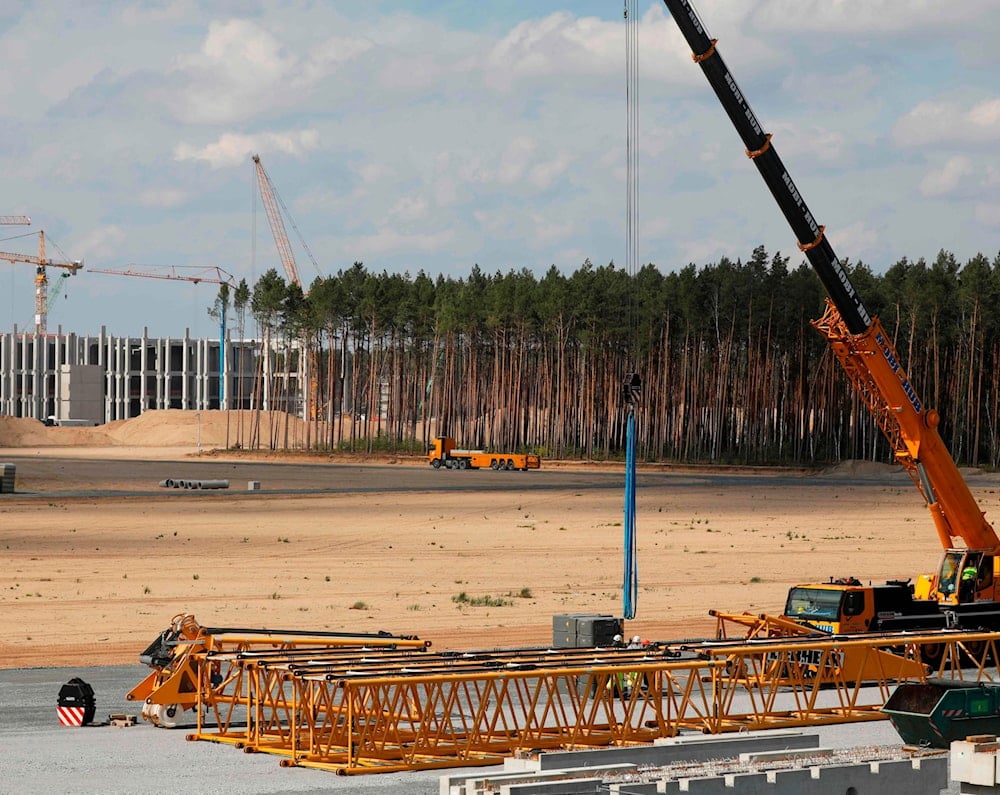Europe losing green land at alarming rate, investigation reveals
A cross-border investigation found that Europe is losing natural and agricultural land at an unprecedented pace, about 600 football fields a day, to housing, roads, and luxury developments, threatening biodiversity, food security, and climate resilience.
-

The construction site for Tesla's gigafactory near Berlin is pictured in September 2020. (AFP)
Europe is rapidly losing its green landscapes to construction, with new data showing that natural and agricultural land is being consumed at an unprecedented pace, the equivalent of 600 football pitches disappearing every day.
A joint investigation by The Guardian and several European media outlets found that between 2018 and 2023, roughly 9,000 square kilometers of green areas, an expanse equal to the size of Cyprus, have been covered by concrete, asphalt, and luxury developments. The findings stem from the Green to Grey project, which partnered with the Norwegian Institute for Nature Research (NINA) to analyze satellite images across 11 European countries.
The study shows Europe is losing around 1,500 square kilometers of land annually, mostly to urban expansion, roads, industrial zones, and high-end resorts. Of this, about 900 square kilometers are natural habitats, while another 600 square kilometers are farmland, raising serious concerns for food security and environmental health.
"Land lost to development is one of the primary drivers of wilderness loss and biodiversity decline," said Steve Carver, a professor of wilderness at the University of Leeds. "But we are also losing cropland and productive land as our cities expand into the green belt and on to agricultural land."
Urban sprawl and luxury developments
Housing and road projects accounted for a quarter of all land converted, but significant losses also came from tourism and recreation aimed at the wealthy.
In Portugal, one of the starkest examples emerged at Galé Beach near Melides, where nearly 300 hectares of protected dunes have been cleared to make way for the CostaTerra Golf and Ocean Club, a luxury resort with multimillion-pound homes. The resort, still under construction, sits within a Natura 2000 conservation zone that is supposed to be safeguarded under EU environmental law.
The project’s backers received permission from Portuguese authorities on the grounds of "economic benefit," a justification environmental advocates have fiercely rejected.
"It is obviously not overriding public interest," said Ioannis Agapakis, a lawyer with the NGO ClientEarth. "The mere fact that you find economic benefits or some type of economic development from a project does not make it overriding public interest."
The US-based developer, Discovery Land Company, defended the project, insisting it follows strict sustainability standards. "We are developing CostaTerra to be a model for environmental stewardship and sustainability in the region," the firm said in a statement.
"Every aspect of the property – from the design of the golf course, to rainwater and waste management practices, to the development and preservation of wildlife habitat and corridors – was designed to meet or exceed EU standards, including the Natura 2000 framework."
Read more: World capitals face escalating heat threat, warns new analysis
Wetlands under threat
In Turkey, similar environmental damage was recorded at the Caltilidere wetland in Izmir province, which has been paved over for a vast marina catering to the global yacht industry. Once a thriving ecosystem that hosted flamingos, pelicans, and sea life, the wetland’s protected status was lifted in 2017 after a contentious local meeting. Satellite imagery now shows concrete foundations stretching across the area.
The project’s developers argue that the marina will bring prosperity to the region. "The richest people in Turkey and in the world will bring their big yachts here and repair them or have them built," said Yatek’s former director in a 2021 interview, claiming the site will support thousands of jobs and allow the manufacture of 132 yachts a year.
In a formal statement, the company said, "The environmental impacts and other ecological aspects of the project have been thoroughly assessed by the competent authorities of our country, which have granted a positive EIA decision. Accordingly, the entire project process continues lawfully and in line with the relevant legislation."
A hidden crisis
Until now, Europe’s loss of green land had never been quantified at this scale. While deforestation in the Amazon and other tropical regions has long been documented, the continent’s creeping urban sprawl, driven by tourism, consumerism, and luxury development, has largely gone unnoticed.
Researchers warn that the ongoing conversion of green land to grey threatens not only biodiversity but also Europe’s resilience against climate change. Forests, wetlands, and farmland act as carbon sinks, flood barriers, and food sources, natural assets that cannot be replaced once sealed under concrete.
The findings reveal a continent reshaping itself at high speed, often in the name of economic growth. Yet as Professor Carver and others caution, the cost is a shrinking wilderness and a deepening ecological crisis that could take centuries to repair.
Read more: Climate change caused 16,500 deaths in European cities in Summer 2025

 5 Min Read
5 Min Read











